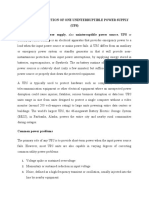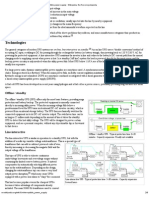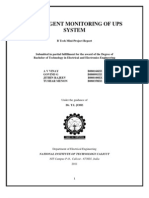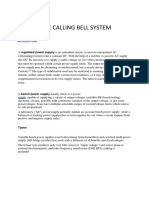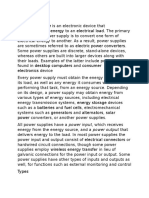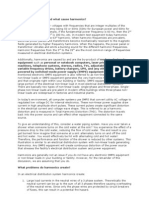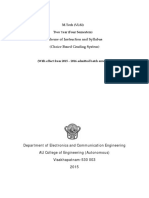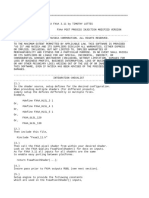Ups
Ups
Uploaded by
mukhtiarali5Copyright:
Available Formats
Ups
Ups
Uploaded by
mukhtiarali5Copyright
Available Formats
Share this document
Did you find this document useful?
Is this content inappropriate?
Copyright:
Available Formats
Ups
Ups
Uploaded by
mukhtiarali5Copyright:
Available Formats
Power failure or blackout is defined as a zero-voltage condition that lasts for more than two cycles.
It may be caused by the tripping of a circuit breaker, power distribution failure or utility power failure. This condition can lead to data damage, data loss, file corruption and hardware damage. Voltage sags are the most common power problem encountered. Sags are a short-term reduction in voltage, and can cause interruptions to older equipment such as adjustable-speed drives, relays, and robots. Sags are most often caused by fuse or breaker operation, motor starting, or capacitor switching. Voltage sags typically are non-repetitive, or repeat only a few times due to recloser operation. Sags can occur on multiple phases or on a single phase and can be accompanied by voltage swells on other phases. Power surge takes place when the voltage is 110% above normal. The most common cause is heavy electrical equipment being turned off. Under this condition, computer systems may experience memory loss, data errors, flickering lights, and equipment shutoff. High-voltage spikes occur when there is a sudden, rapid voltage peak of up to 6,000 volts. These spikes are usually the result of nearby lightning strikes, but there can be other causes as well. The effects on vulnerable electronic systems can include loss of data and burned circuit boards. Switching transients take place when there is a rapid voltage peak of up to 20,000 volts with a duration of 10 microseconds to 100 microseconds. They are commonly caused by arcing faults and static discharge. In addition, major power system switching disturbances initiated by the utilities to correct line problems may happen several times a day. Effects can include memory loss, data error, data loss and component stress. Electrical line noise is defined as Radio Frequency Interference (RFI) and Electromagnetic Interference (EMI) and causes undesirable effects in the circuits of computer systems. Sources of the problem include electric motors, relays, motor control devices, broadcast transmissions, microwave radiation, and distant electrical storms. RFI, EMI and other frequency problems can cause data error, data loss, storage loss, keyboard lockup and system lockup. Frequency variation involves a change in frequency from the normally stable utility frequency of 50 Hz or 60 Hz, depending on the geographic location. This may be caused by erratic operation of emergency generators or unstable frequency power sources. For sensitive electronic equipment, the result can be data corruption, hard drive crash, keyboard lockup and program failure. However, current EDP equipment is not nearly as sensitive to minor frequency swings. Brownout is a steady lower voltage state. An example of a brownout happens during peak electrical demands in the summer, when utilities cant always meet the requirements and must lower the voltage to limit maximum power. When this happens, computer systems can experience data corruption, data loss and premature hardware failure. Over voltage is a steady higher voltage state that can last anywhere from a few minutes to a few days.
Offline / standby Offline / standby UPS. Typical protection time: 020 minutes. Capacity expansion: Usually not available The offline / standby UPS (SPS) offers only the most basic features, providing surge protection and battery backup. The protected equipment is normally connected directly to incoming utility power. When the incoming voltage falls below a predetermined level the SPS turns on its internal
DC-AC inverter circuitry, which is powered from an internal storage battery. The SPS then mechanically switches the connected equipment on to its DC-AC inverter output. The switchover time can be as long as 25 milliseconds depending on the amount of time it takes the standby UPS to detect the lost utility voltage. The UPS will be designed to power certain equipment, such as a personal computer, without any objectionable dip or brownout to that device. Line-interactive Line-interactive UPS. Typical protection time: 530 minutes. Capacity expansion: Several hours The line-interactive UPS is similar in operation to a standby UPS, but with the addition of a multitap variable-voltage autotransformer. This is a special type of transformer that can add or subtract powered coils of wire, thereby increasing or decreasing the magnetic field and the output voltage of the transformer. This type of UPS is able to tolerate continuous undervoltage brownouts and overvoltage surges without consuming the limited reserve battery power. It instead compensates by automatically selecting different power taps on the autotransformer. Depending on the design, changing the autotransformer tap can cause a very brief output power disruption,[4] which may cause UPSs equipped with a power-loss alarm to "chirp" for a moment. This has become popular even in the cheapest UPSs because it takes advantage of components already included. The main 50/60 Hz transformer used to convert between line voltage and battery voltage needs to provide two slightly different turns ratios: one to convert the battery output voltage (typically a multiple of 12 V) to line voltage, and a second one to convert the line voltage to a slightly higher battery charging voltage (such as a multiple of 14 V). Further, it is easier to do the switching on the line-voltage side of the transformer because of the lower currents on that side. To gain the buck/boost feature, all that is required is two separate switches so that the AC input can be connected to one of the two primary taps, while the load is connected to the other, thus using the main transformer's primary windings as an autotransformer. The battery can still be charged while "bucking" an overvoltage, but while "boosting" an undervoltage, the transformer output is too low to charge the batteries. Autotransformers can be engineered to cover a wide range of varying input voltages, but this requires more taps and increases complexity, and expense of the UPS. It is common for the autotransformer to cover a range only from about 90 V to 140 V for 120 V power, and then switch to battery if the voltage goes much higher or lower than that range. In low-voltage conditions the UPS will use more current than normal so it may need a higher current circuit than a normal device. For example to power a 1000-watt device at 120 volts, the UPS will draw 8.32 amperes. If a brownout occurs and the voltage drops to 100 volts, the UPS will draw 10 amperes to compensate. This also works in reverse, so that in an overvoltage condition, the UPS will need less current. Double-conversion / online Typical protection time: 530 minutes Capacity expansion: Several hours The online UPS is ideal for environments where electrical isolation is necessary or for equipment that is very sensitive to power fluctuations. Although once previously reserved for very large installations of 10 kW or more, advances in technology have now permitted it to be available as a common consumer device, supplying 500 watts or less. The initial cost of the online UPS may be slightly higher, but its total cost of ownership is generally lower due to longer battery life. The
online UPS may be necessary when the power environment is "noisy", when utility power sags, outages and other anomalies are frequent, when protection of sensitive IT equipment loads is required, or when operation from an extended-run backup generator is necessary. The basic technology of the online UPS is the same as in a standby or line-interactive UPS. However it typically costs much more, due to it having a much greater current AC-to-DC batterycharger/rectifier, and with the rectifier and inverter designed to run continuously with improved cooling systems. It is called a double-conversion UPS due to the rectifier directly driving the inverter, even when powered from normal AC current. In an online UPS, the batteries are always connected to the inverter, so that no power transfer switches are necessary. When power loss occurs, the rectifier simply drops out of the circuit and the batteries keep the power steady and unchanged. When power is restored, the rectifier resumes carrying most of the load and begins charging the batteries, though the charging current may be limited to prevent the high-power rectifier from overheating the batteries and boiling off the electrolyte. The main advantage to the on-line UPS is its ability to provide an electrical firewall between the incoming utility power and sensitive electronic equipment. While the standby and line-interactive UPS merely filter the input utility power, the double-conversion UPS provides a layer of insulation from power quality problems. It allows control of output voltage and frequency regardless of input voltage and frequency.\ Transistor A transistor is a semiconductor device used to amplify and switch electronic signals and power. It is composed of a semiconductor material with at least three terminals for connection to an external circuit. A voltage or current applied to one pair of the transistor's terminals changes the current flowing through another pair of terminals. Because the controlled (output) power can be much more than the controlling (input) power, a transistor can amplify a signal. Today, some transistors are packaged individually, but many more are found embedded in integrated circuits. The transistor is the fundamental building block of modern electronic devices, and is ubiquitous in modern electronic systems. Following its release in the early 1950s the transistor revolutionized the field of electronics, and paved the way for smaller and cheaper radios, calculators, and computers, among other things. Diode In electronics, a diode is a type of two-terminal electronic component with a nonlinear current voltage characteristic. A semiconductor diode, the most common type today, is a crystalline piece of semiconductor material connected to two electrical terminals.[1] A vacuum tube diode (now rarely used except in some high-power technologies) is a vacuum tube with two electrodes: a plate and a cathode. The most common function of a diode is to allow an electric current to pass in one direction (called the diode's forward direction), while blocking current in the opposite direction (the reverse direction). Thus, the diode can be thought of as an electronic version of a check valve. This unidirectional behavior is called rectification, and is used to convert alternating current to direct current, and to extract modulation from radio signals in radio receivers. However, diodes can have more complicated behavior than this simple onoff action. Semiconductor diodes do not begin conducting electricity until a certain threshold voltage is present in the forward direction (a state in which the diode is said to be forward biased). The voltage drop across a forward biased diode varies only a little with the current, and is a function of
temperature; this effect can be used as a temperature sensor or voltage reference. Semiconductor diodes have nonlinear electrical characteristics, which can be tailored by varying the construction of their PN junction. These are exploited in special purpose diodes that perform many different functions. For example, diodes are used to regulate voltage (Zener diodes), to protect circuits from high voltage surges (Avalanche diodes), to electronically tune radio and TV receivers (varactor diodes), to generate radio frequency oscillations (tunnel diodes, Gunn diodes, IMPATT diodes), and to produce light (light emitting diodes). Tunnel diodes exhibit negative resistance, which makes them useful in some types of circuits. Diodes were the first semiconductor electronic devices. The discovery of crystals' rectifying abilities was made by German physicist Ferdinand Braun in 1874. The first semiconductor diodes, called cat's whisker diodes, developed around 1906, were made of mineral crystals such as galena. Today most diodes are made of silicon, but other semiconductors such as germanium are sometimes used.[2]
You might also like
- The Road AheadDocument179 pagesThe Road AheadSanjay Chauhan100% (2)
- Biax 7EL Assembly - RepairDocument6 pagesBiax 7EL Assembly - RepairKarsten BergNo ratings yet
- TuffStuff Smith Press Attachment (CXT-225) Owner's ManualDocument23 pagesTuffStuff Smith Press Attachment (CXT-225) Owner's ManualCharlieNo ratings yet
- Uninterruptible Power SupplyDocument12 pagesUninterruptible Power SupplyJameer AsifNo ratings yet
- Uninterruptible Power SupplyDocument16 pagesUninterruptible Power SupplyorlandochavezmoraNo ratings yet
- Uninterruptible Power Supply - WikipediaDocument82 pagesUninterruptible Power Supply - WikipediaKalimbwe TutaNo ratings yet
- Design Construction of One Uninterruptible Power Supply (UPS)Document25 pagesDesign Construction of One Uninterruptible Power Supply (UPS)Suva nilNo ratings yet
- Uninterruptible Power SupplyDocument5 pagesUninterruptible Power SupplyddipyenduNo ratings yet
- Uninterrupted Power Supply ArticleDocument14 pagesUninterrupted Power Supply ArticlechukwunemeNo ratings yet
- Computer Science Draft 1Document17 pagesComputer Science Draft 1Paris JosephNo ratings yet
- Power ProtectionDocument17 pagesPower ProtectionParis JosephNo ratings yet
- A Power Supply UnitDocument11 pagesA Power Supply UnitShin Jae JiNo ratings yet
- Teoria SAI-UPS 20Document9 pagesTeoria SAI-UPS 20ZapataNo ratings yet
- Power SupplyDocument9 pagesPower SupplyMuhammed HuzaifaNo ratings yet
- Uninterruptible Power Supply and InvertersDocument10 pagesUninterruptible Power Supply and InvertersnicenezaNo ratings yet
- SMPSDocument30 pagesSMPStulugugayatri73No ratings yet
- Uninterruptible Power SupplyDocument3 pagesUninterruptible Power SupplyjancukoeNo ratings yet
- UPSDocument54 pagesUPSy m d100% (1)
- Uninterruptible Power Supply - Wikipedia, The Free EncyclopediaDocument1 pageUninterruptible Power Supply - Wikipedia, The Free EncyclopediaAnkit DhimanNo ratings yet
- Arduino Base Over Voltage and Under Voltage Protection Circuit LITERATURE REVIEWDocument23 pagesArduino Base Over Voltage and Under Voltage Protection Circuit LITERATURE REVIEWOlasupo IyaboNo ratings yet
- Types of UPS 2Document3 pagesTypes of UPS 2Pedro MauricioNo ratings yet
- CHIMEZIE_GRACEDocument13 pagesCHIMEZIE_GRACErajesh kothariNo ratings yet
- Final of Atif UpsDocument99 pagesFinal of Atif UpsSajid HussainNo ratings yet
- (Edit) Power Supply TypesDocument8 pages(Edit) Power Supply Typeshazel violetNo ratings yet
- UPS TheoryDocument50 pagesUPS Theoryajaykumarparikh100% (2)
- Voltage Surge SuppressorDocument5 pagesVoltage Surge SuppressorKanai BanerjeeNo ratings yet
- Ups (Uninterruptible Power Supply) : Disusun OlehDocument18 pagesUps (Uninterruptible Power Supply) : Disusun OlehDevia Rafika PNo ratings yet
- Power Supply: Citations VerificationDocument30 pagesPower Supply: Citations VerificationIvy TomasNo ratings yet
- UpsDocument27 pagesUpsmatthew02012010No ratings yet
- Ups UpsDocument92 pagesUps UpsHARSHIT SONI gs2117090No ratings yet
- Power Line Disturbance PDFDocument63 pagesPower Line Disturbance PDFs31314100% (1)
- UPS Project NewDocument34 pagesUPS Project NewKrishna RajNo ratings yet
- A Power Supply Is A Device That Supplies Electric Power To An Electrical LoadDocument14 pagesA Power Supply Is A Device That Supplies Electric Power To An Electrical LoadElizabeth HarrisNo ratings yet
- Type of Power SupplyDocument7 pagesType of Power SupplySHah WanHazNo ratings yet
- Practical 2Document7 pagesPractical 2Sunny DograNo ratings yet
- What Your IT Equipment Needs From A UPSDocument4 pagesWhat Your IT Equipment Needs From A UPSrajuanthatiNo ratings yet
- Intelligent Monitoring of Ups System: Under The Guidance ofDocument40 pagesIntelligent Monitoring of Ups System: Under The Guidance ofTushar MenonNo ratings yet
- Uninterruptible Power Supply (UPS)Document14 pagesUninterruptible Power Supply (UPS)Dharam SharmaNo ratings yet
- Report On Power SupplyDocument14 pagesReport On Power SupplyBhavesh MaheshwariNo ratings yet
- Power SupplyDocument13 pagesPower SupplyDinesh MahajanNo ratings yet
- Specifying Power Conditioning Equipment.: 0 CommentsDocument48 pagesSpecifying Power Conditioning Equipment.: 0 CommentsrajuanthatiNo ratings yet
- MechanicalDocument5 pagesMechanicalvaneeza ahmedNo ratings yet
- Uninterruptable Power Supply UPSDocument7 pagesUninterruptable Power Supply UPSraul_bsuNo ratings yet
- Selection of Various Types of UPS (Part-2) : (2) Line-Inter Active UPSDocument14 pagesSelection of Various Types of UPS (Part-2) : (2) Line-Inter Active UPSJIMMY ANTONYNo ratings yet
- Uday Edition 03Document12 pagesUday Edition 03Gulani Sai TejANo ratings yet
- Dokumen tanpa judul(2)Document7 pagesDokumen tanpa judul(2)attarNo ratings yet
- RX TX and Power SupplyDocument10 pagesRX TX and Power SupplyPrashant LochamNo ratings yet
- ND RD RDDocument10 pagesND RD RDHasan CagatayNo ratings yet
- Capacitor Switching and Capacitor Switching Devices-NOTA TECNICADocument11 pagesCapacitor Switching and Capacitor Switching Devices-NOTA TECNICAEdgardo Kat ReyesNo ratings yet
- Power Line DisturbancesDocument62 pagesPower Line Disturbancesrogerwoo988No ratings yet
- Uninterruptible Power Supply (UPS) Secure 650VADocument7 pagesUninterruptible Power Supply (UPS) Secure 650VAAaron EstacionNo ratings yet
- A Report On Mosfet BasedDocument30 pagesA Report On Mosfet Baseddinesh23723100% (1)
- Power Factor Measurement & Correction: Prepared By: Guided byDocument29 pagesPower Factor Measurement & Correction: Prepared By: Guided bySunil PillaiNo ratings yet
- UPS Working Principle TypesDocument11 pagesUPS Working Principle Typeswasif upolNo ratings yet
- Implementation of Inverse Define Minimum Time Under and Over Voltage RelayDocument6 pagesImplementation of Inverse Define Minimum Time Under and Over Voltage RelayRika Elvan YulindaNo ratings yet
- BUILDING SERVICES IIQuestion BankDocument37 pagesBUILDING SERVICES IIQuestion BankSiva Raman100% (1)
- Reference Guide To Useful Electronic Circuits And Circuit Design Techniques - Part 1From EverandReference Guide To Useful Electronic Circuits And Circuit Design Techniques - Part 1Rating: 2.5 out of 5 stars2.5/5 (3)
- Introduction to Power System ProtectionFrom EverandIntroduction to Power System ProtectionRating: 5 out of 5 stars5/5 (1)
- Analog Dialogue Volume 46, Number 1: Analog Dialogue, #5From EverandAnalog Dialogue Volume 46, Number 1: Analog Dialogue, #5Rating: 5 out of 5 stars5/5 (1)
- Reference Guide To Useful Electronic Circuits And Circuit Design Techniques - Part 2From EverandReference Guide To Useful Electronic Circuits And Circuit Design Techniques - Part 2No ratings yet
- Philips Chassis L01L AC PDFDocument83 pagesPhilips Chassis L01L AC PDFDaniel Castrellon MedellinNo ratings yet
- GampDocument45 pagesGampsina20795No ratings yet
- AC Centrifugal Fan: R2E280-AE52-17Document5 pagesAC Centrifugal Fan: R2E280-AE52-17nalasekaranNo ratings yet
- Text and Face DetectionDocument82 pagesText and Face DetectionGangadhar BiradarNo ratings yet
- X5Nav Retrofit 16 9Document37 pagesX5Nav Retrofit 16 9nmaiorNo ratings yet
- Quick-Start Guide: Wyse E01 Zero ClientDocument2 pagesQuick-Start Guide: Wyse E01 Zero ClientJoe0411975No ratings yet
- Embedded - How Do NAND Flash Memory Writes Work - Electrical Engineering Stack ExchangeDocument3 pagesEmbedded - How Do NAND Flash Memory Writes Work - Electrical Engineering Stack ExchangeSckajalaNo ratings yet
- Optiplex 780 Tech GuideDocument49 pagesOptiplex 780 Tech GuideLuis Efrain Simbaña TacoNo ratings yet
- This Unit: Arithmetic and ALU Design Floating Point ArithmeticDocument8 pagesThis Unit: Arithmetic and ALU Design Floating Point ArithmeticPhạm HyuNaNo ratings yet
- Computer Graphics Lab Report Bezier Curve ImplementationDocument4 pagesComputer Graphics Lab Report Bezier Curve ImplementationNaman GoyalNo ratings yet
- gMUC User ManualDocument28 pagesgMUC User Manualmstin22No ratings yet
- Kathrein 782 10860 PDFDocument2 pagesKathrein 782 10860 PDFvyshyNo ratings yet
- Computer Fundamentals-1L1CS - LessonPlan2024Document3 pagesComputer Fundamentals-1L1CS - LessonPlan2024mapolosa2001No ratings yet
- MTech VLSI Syllabus 2015 16Document43 pagesMTech VLSI Syllabus 2015 16palagani muralibabuNo ratings yet
- Structures OSDocument18 pagesStructures OSSahil NagarNo ratings yet
- Lab 01 - Examine Seismic Data 2Document6 pagesLab 01 - Examine Seismic Data 2api-323770220No ratings yet
- PG Sue LVTD V1 00Document12 pagesPG Sue LVTD V1 00John ArdnosilNo ratings yet
- 301 - FortiGate Multi-Threat Security Systems LL PDFDocument13 pages301 - FortiGate Multi-Threat Security Systems LL PDFRodrigo PissinNo ratings yet
- Fxaa3 11.hDocument16 pagesFxaa3 11.hMohamed OuattaraNo ratings yet
- Citect Bailey DriverDocument52 pagesCitect Bailey Driverdaniel_os_99No ratings yet
- MB Memory Ga F2a88xn WifiDocument4 pagesMB Memory Ga F2a88xn WifiHectorNo ratings yet
- Installation: Base Transceiver Station Equipment Imn:Btse Bs40Document62 pagesInstallation: Base Transceiver Station Equipment Imn:Btse Bs40AlexandarNo ratings yet
- 42av500p PDFDocument132 pages42av500p PDFOsama YaseenNo ratings yet
- Seatex MRU 6 & 4: Installation ManualDocument148 pagesSeatex MRU 6 & 4: Installation ManualBhayu alfianNo ratings yet
- Operator & Installation Manual Tr-810 857645Document50 pagesOperator & Installation Manual Tr-810 857645बासुदेव अर्यालNo ratings yet
- 240-147174608 Anti-Vandal Measures Guideline For Overhead Power Lines - Rev 2Document37 pages240-147174608 Anti-Vandal Measures Guideline For Overhead Power Lines - Rev 2yaoyangyu038No ratings yet
- User Manual: 60W PD Wall ChargerDocument1 pageUser Manual: 60W PD Wall ChargerFathur RochmanNo ratings yet






